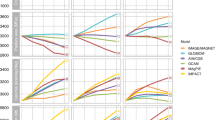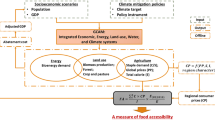Abstract
Land use is one of the key elements in global computable general equilibrium models for food security and agricultural assessment. Constant elasticity transformation (CET) or logit functions have been used to allocate land. CET has the advantage that it is easily handled by modeling tools. However, it does not maintain area balance, whereas logit does. This article compares both functions in future scenarios and evaluates area balance violations of land use area made by CET. We found that agricultural goods production and land use were similar with CET and logit functions. The area balance violation generated by CET was large and heterogeneous across regions, but was small for the aggregated world total. In conclusion, the logit approach was preferable to the CET approach if any scenario assumption, such as consumption preference, changed by much from the base year, or if the main focus of the study was region-specific variables rather than global aggregates.













Similar content being viewed by others
Notes
The shapes of the CES and CET functions are the same. The difference is the sign of the elasticity parameter. CES has positive elasticity, whereas CET has negative elasticity.
The land rent in this case is a rent divided by average cropland rent.
References
Avetisyan, M., Baldos, U., & Hertel, T. W. (2011). Development of the GTAP Version 7 Land Use Data Base. GTAP Research Memorandum (Vol. 19).
Bruinsma, J. (2010). The resource outlook to 2050: by how much do land, water and crop yields need to increase by 2050?, Expert meeting on how to feed the world in 2050.
Dimaranan, B. V. (2006). Global trade, assistance, and production: the GTAP 6 data base. In D. B.V. (Ed.). Center for Global Trade Analysis, Purdue University.
FAO (2013). FAOSTAT. In FAO (Ed.). Rome, Italy.
Fujimori, S., & Matsuoka, Y. (2011). Development of method for estimation of world industrial energy consumption and its application. Energy Economics, 33(3), 461–473. doi:10.1016/j.eneco.2011.01.010.
Fujimori, S., Masui, T., & Matsuoka, Y. (2012). AIM/CGE [basic] manual. Discussion paper series: Center for Social and Environmental Systems Research, National Institute Environemntal Studies.
Fujimori, S., Masui, T., & Matsuoka, Y. (2014). Development of a global computable general equilibrium model coupled with detailed energy end-use technology. Applied Energy, 128, 296–306. doi:10.1016/j.apenergy.2014.04.074.
Golub, A. A., & Hertel, T. W. (2012). Modeling land-use change impacts of biofuels in the gtap-bio framework. Climate Change Economics, 03(03), 1250015. doi:10.1142/S2010007812500157.
Golub, A. A., Henderson, B. B., Hertel, T. W., Gerber, P. J., Rose, S. K., & Sohngen, B. (2013). Global climate policy impacts on livestock, land use, livelihoods, and food security. Proceedings of the National Academy of Sciences, 110(52), 20894–20899. doi:10.1073/pnas.1108772109.
Gurgel, A., Reilly, J. M., & Paltsev, S. (2007). Potential Land Use Implications of a Global Biofuels Industry. Journal of Agricultural & Food Industrial Organization, 5(2), article 9, doi:10.2202/1542-0485.1202.
Hasegawa, T., Fujimori, S., Shin, Y., Takahashi, K., Masui, T., & Tanaka, A. (2014). Climate change impact and adaptation assessment on food consumption utilizing a New scenario framework. Environmental Science and Technology, 48(1), 438–445. doi:10.1021/es4034149.
Hurtt, G. C., Chini, L. P., Frolking, S., Betts, R. A., Feddema, J., Fischer, G., et al. (2011). Harmonization of land-use scenarios for the period 1500–2100: 600 years of global gridded annual land-use transitions, wood harvest, and resulting secondary lands. Climatic Change, 109(1–2), 117–161. doi:10.1007/s10584-011-0153-2.
IEA (2009a). Energy balances for non-OECD countries. In OECD/IEA (Ed.). Paris, France.
IEA (2009b). Energy balances for OECD countries. In OECD/IEA (Ed.). Paris, France.
IIASA (2012). Shared Socioeconomic Pathways (SSP) Database Version 0.9.3. https://secure.iiasa.ac.at/web-apps/ene/SspDb.
Kyle, P., Luckow, P., Calvin, K., Emanuel, W., Nathan, M., & Zhou, Y. (2011). GCAM 3.0 Agriculture and Land Use: Data Sources and Methods. PACIFIC NORTHWEST NATIONAL LABORATORY.
Laborde, D., & Valin, H. (2012). Modeling land-use changes in a global cge: assessing the eu biofuel mandates with the mirage-biof model. Climate Change Economics, 03(03), 1250017. doi:10.1142/S2010007812500170.
Lofgren, H., Harris, R. L., & Robinson, S. (2002). A standard computable general equilibrium (cge) model in gams. MICROCOMPUTERS IN POLICY RESEARCH (Vol. 5): International Food Policy Research Institute.
Monfreda, C., Ramankutty, N., & Hertel, T. (2008). Global Agricultural Land Use Data for Climate Change Analysis (Routledge explorations.
Moss, R. H., Edmonds, J. A., Hibbard, K. A., Manning, M. R., Rose, S. K., van Vuuren, D. P., et al. (2010). The next generation of scenarios for climate change research and assessment. Nature, 463(7282), 747–756. doi:10.1038/nature08823.
Msangi, S., Ewing, M., Rosegrant, M. W., & Zhu, T. (2010). Biofuels, Food Security, and the Environment: A 2020/2050 Perspective. 65–94, doi:10.1007/978-3-642-04615-5_4.
OECD. (2010). Input–output tables. Paris: Organization for Economic Cooperation and Development.
Robinson, S., van Meijl, H., Willenbockel, D., Valin, H., Fujimori, S., Masui, T., et al. (2014). Comparing supply-side specifications in models of global agriculture and the food system. Agricultural Economics, 45(1), 21–35. doi:10.1111/agec.12087.
Rutherford, T. F. (1995). Extension of GAMS for complementarity problems arising in applied economic analysis. Journal of Economic Dynamics and Control, 19(8), 1299–1324. doi:10.1016/0165-1889(94)00831-2.
Sands, R., & Leimbach, M. (2003). Modeling agriculture and land Use in an integrated assessment framework. Climatic Change, 56(1–2), 185–210. doi:10.1023/A:1021344614845.
Schmitz, C., van Meijl, H., Kyle, P., Nelson, G. C., Fujimori, S., Gurgel, A., et al. (2014). Land-use change trajectories up to 2050: insights from a global agro-economic model comparison. Agricultural Economics, 45(1), 69–84. doi:10.1111/agec.12090.
Schumacher, K., & Sands, R. D. (2006). Innovative energy technologies and climate policy in Germany. Energy Policy, 34(18), 3929–3941. doi:10.1016/j.enpol.2005.09.022.
Thepkhun, P., Limmeechokchai, B., Fujimori, S., Masui, T., & Shrestha, R. M. (2013). Thailand’s Low-Carbon Scenario 2050: The AIM/CGE analyses of CO2 mitigation measures. Energy Policy, 62, 561–572. doi:10.1016/j.enpol.2013.07.037.
UN (2007a). National Accounts Main Aggregates Database. In U. Nations (Ed.). New York, USA.
UN (2007b). United Nations Commodity Trade Statistics Database. In U. Nations (Ed.). New York, USA.
UNIDO (2009). INDSTAT2 - 2009 edition. In U. N. I. D. O. (UNIDO) (Ed.). Vienna, Austria.
von Lampe, M., Willenbockel, D., Ahammad, H., Blanc, E., Cai, Y., Calvin, K., et al. (2014). Why do global long-term scenarios for agriculture differ? An overview of the AgMIP Global Economic Model Intercomparison. Agricultural Economics, 45(1), 3–20. doi:10.1111/agec.12086.
Wise, M., & Calvin, K. (2011). GCAM 3.0 Agriculture and Land Use; Technical Description of Modeling Approach. PNNL (Vol. 20971).
You, L., S.Crespo, Guo, Z., Koo, J., Ojo, W., Sebastian, K., et al. (2012). Spatial Produciton Allocation Model (SPAM) 2000 Version 3 Release 2. http://MapSPAM.info. Accessed 10/01 2012.
Acknowledgments
This study was supported by the “Global Environmental Research Fund” S-10, and 2–1402 of the Ministry of the Environment of Japan. The authors would like to acknowledge the generosity of these funds. Finally, we wish to thank two anonymous reviewers for their comments which substantially improved the paper.
Author information
Authors and Affiliations
Corresponding author
Additional information
Author contributions: S.F. was responsible for the study design, data analysis and manuscript preparation. T.H. contributed data and manuscript preparation. T.M. and K.T. assisted with the study design and helped write the manuscript.
Electronic supplementary material
Below is the link to the electronic supplementary material.
ESM 1
(DOC 235 kb)
Rights and permissions
About this article
Cite this article
Fujimori, S., Hasegawa, T., Masui, T. et al. Land use representation in a global CGE model for long-term simulation: CET vs. logit functions. Food Sec. 6, 685–699 (2014). https://doi.org/10.1007/s12571-014-0375-z
Received:
Accepted:
Published:
Issue Date:
DOI: https://doi.org/10.1007/s12571-014-0375-z




